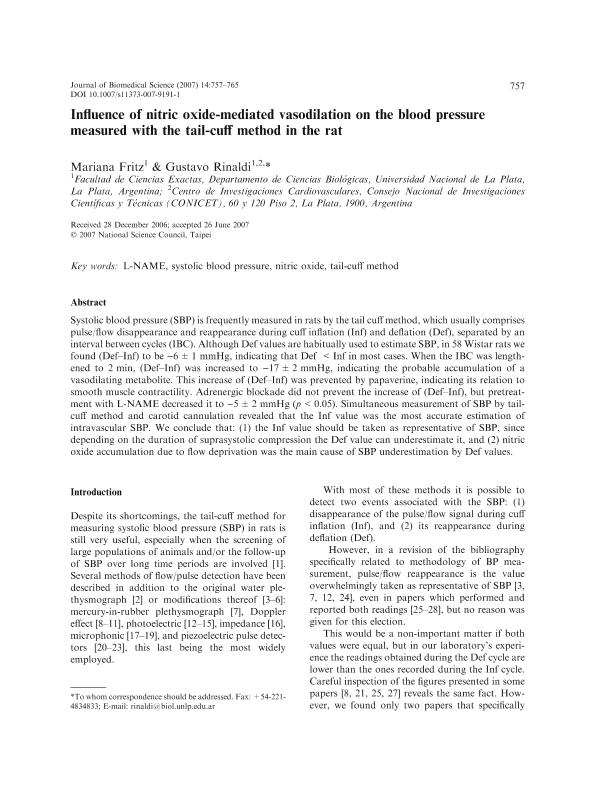Artículo
Influence of nitric oxide-mediated vasodilation on the blood pressure measured with the tail-cuff method in the rat
Fecha de publicación:
18/07/2007
Editorial:
BioMed Central
Revista:
Journal Of Biomedical Science
ISSN:
1021-7770
e-ISSN:
1423-0127
Idioma:
Inglés
Tipo de recurso:
Artículo publicado
Clasificación temática:
Resumen
Systolic blood pressure (SBP) is frequently measured in rats by the tail cuff method, which usually comprises pulse/flow disappearance and reappearance during cuff inflation (Inf) and deflation (Def), separated by an interval between cycles (IBC). Although Def values are habitually used to estimate SBP, in 58 Wistar rats we found (Def-Inf) to be -6 ± 1 mmHg, indicating that Def < Inf in most cases. When the IBC was lengthened to 2 min, (Def-Inf) was increased to -17 ± 2 mmHg, indicating the probable accumulation of a vasodilating metabolite. This increase of (Def-Inf) was prevented by papaverine, indicating its relation to smooth muscle contractility. Adrenergic blockade did not prevent the increase of (Def-Inf), but pretreatment with L-NAME decreased it to -5 ± 2 mmHg (p < 0.05). Simultaneous measurement of SBP by tail-cuff method and carotid cannulation revealed that the Inf value was the most accurate estimation of intravascular SBP. We conclude that: (1) the Inf value should be taken as representative of SBP, since depending on the duration of suprasystolic compression the Def value can underestimate it, and (2) nitric oxide accumulation due to flow deprivation was the main cause of SBP underestimation by Def values. © 2007 National Science Council.
Palabras clave:
L-NAME
,
NITRIC OXIDE
,
SYSTOLIC BLOOD PRESSURE
,
TAIL-CUFF METHOD
Archivos asociados
Licencia
Identificadores
Colecciones
Articulos(CIC)
Articulos de CENTRO DE INVEST.CARDIOVASCULARES (I)
Articulos de CENTRO DE INVEST.CARDIOVASCULARES (I)
Articulos(CIDCA)
Articulos de CENTRO DE INV EN CRIOTECNOLOGIA DE ALIMENTOS (I)
Articulos de CENTRO DE INV EN CRIOTECNOLOGIA DE ALIMENTOS (I)
Citación
Fritz, Mariana; Rinaldi, Gustavo Juan; Influence of nitric oxide-mediated vasodilation on the blood pressure measured with the tail-cuff method in the rat; BioMed Central; Journal Of Biomedical Science; 14; 6; 18-7-2007; 757-765
Compartir
Altmétricas




